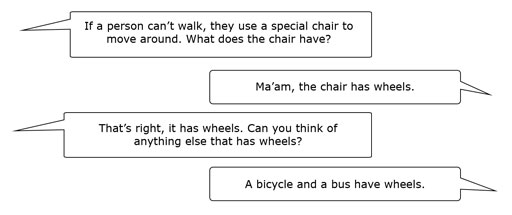2 Using different techniques to help students understand and learn new words
There are many ways that you can help students to understand new words. You can translate words, and you can ask students to guess meanings. At first, students may find it difficult to guess the meanings of words. You can show them how to guess meanings by using their existing knowledge of English, their understanding of the other words in the lesson, and their knowledge of the world. Read this sentence from ‘A Visit to Cambridge’ (see Resource 3):
There was his assistant on the line and I told him I had come in a wheelchair from India (perhaps he thought I had propelled myself all the way) to write about my travels in Britain.
Students can guess the meaning of the word ‘wheelchair’ if they understand the words ‘wheel’ and ‘chair’, and by their knowledge of the world – they understand that a disabled person might use a wheelchair, and they may have seen one.
They can also make a good guess of the word ‘propelled’ once they understand the word ‘wheelchair’ and the topic of the lesson. They can see that it is a verb. It is used as part of the past perfect tense, and it has the ending ‘–ed’. When they know it is a verb, they can guess that it involves movement. By understanding how a person uses a wheelchair, they can guess the exact meaning of the word.
Pause for thought Can you think of any other ways that you could help students to understand the words ‘wheelchair’ and ‘propel’? If you can, discuss them with a colleague and note your ideas. |
Other ways that you can help students to understand new words include:
- Using a picture or a real object: You could draw a picture of a wheelchair on the board, use a picture from the textbook or cut out a picture from a magazine or newspaper.
- Using mime or gesture: You could mime a person propelling themselves in a wheelchair and ask students to say what the word is in their home language to check that they understand.
- Giving examples of the words in a different context and asking students to guess: For example, you could say: ‘The boat was propelled across the water by the wind.’
- Explaining what the word means in English: Ask questions to make sure that your students understand the meaning.

Remember that you don’t have to use all of these techniques each time your students need to know a new word! Different techniques suit different words; for example, it can be easy and quick to mime an action. See Resource 4, ‘Using questioning to promote thinking’, for more on using questions to involve students.
Activity 3: Using different techniques to help your students understand and learn new words
This is an activity for you to do in the classroom with your students.
Using a variety of techniques will help your students to understand new words, and it will also help them to remember them better. They might remember the picture that you drew on the board, or the enjoyable mime. Follow these steps and try some different techniques in your classroom:
- Choose a lesson from your textbook. It can be any lesson, including prose or poetry. It could even be the next one you teach. If the lesson is long, choose a few paragraphs or verses.
- Before the lesson, select some words that you think your students won’t know. If you are not familiar with some of the words, you might like to look them up in a dictionary. (See the additional resources section of this unit for links to online dictionaries.) Practise saying the words and phrases out loud so that students can repeat them after you.
- Decide how you could help your students understand these words. Could you draw or mime them? Can you think of some other examples of sentences using the word? How could you explain the word in English? What questions could you ask your students to check that they understand (for example: ‘What is the opposite of this word?’)
- Before your students read the lesson, write the words on the board.
- Ask your students if they know what the words mean. If they don’t know, help them to understand using the different techniques that you prepared. If they are having difficulty understanding, try another technique. Try to avoid using translation if possible; try to use it only as a last resort. See Resource 2 for some of the language you could use to teach vocabulary.
1 Helping students to understand unknown English vocabulary in lessons
